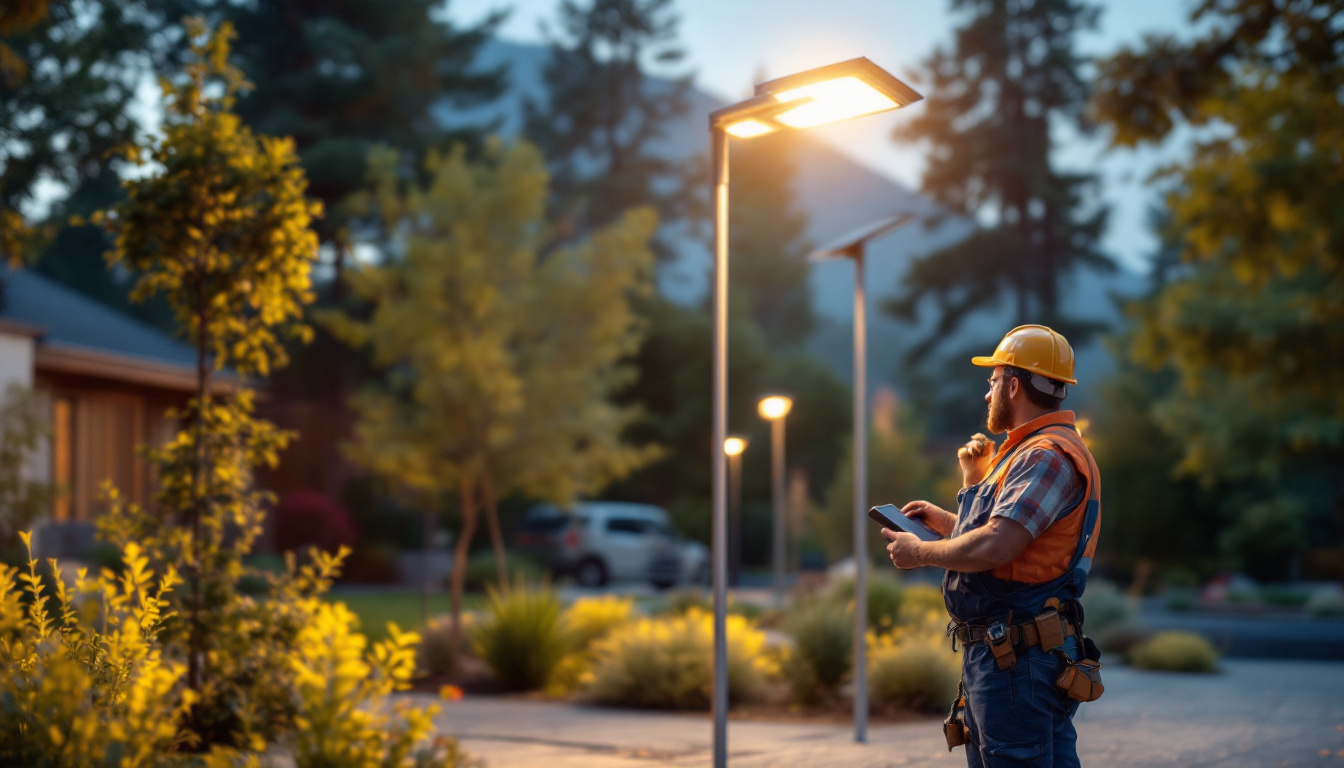
As the demand for sustainable and energy-efficient lighting solutions continues to grow, tall solar lights have emerged as a popular choice for both residential and commercial applications. For lighting contractors, understanding the nuances of these fixtures is essential to ensure successful installations and satisfied clients. This article will explore the do’s and don’ts of working with tall solar lights, providing insights that can enhance project outcomes and client relationships.
Tall solar lights serve a variety of purposes, from enhancing security to improving aesthetics in outdoor spaces. Their elevated design allows for broader illumination coverage, making them ideal for parks, pathways, and parking lots. Moreover, they harness solar energy, reducing reliance on traditional power sources and contributing to environmental sustainability.
As a lighting contractor, recognizing the significance of these fixtures can help in recommending the right solutions to clients. Understanding their benefits, limitations, and installation requirements is crucial for delivering high-quality service.
One of the primary advantages of tall solar lights is their energy efficiency. By utilizing solar panels, these lights can operate independently of the electrical grid, leading to significant cost savings over time. This feature is particularly appealing to clients looking to minimize their energy bills.
Additionally, tall solar lights are often equipped with advanced technology, such as motion sensors and dimming capabilities, which enhance their functionality. These features not only improve safety but also extend the lifespan of the lights by conserving energy when full brightness is not needed. The integration of smart technology also allows for remote monitoring and control, enabling users to adjust settings according to their specific needs and preferences.
Tall solar lights can be effectively used in a multitude of settings. In residential areas, they can illuminate driveways and gardens, providing both safety and aesthetic appeal. In commercial environments, they are ideal for parking lots and outdoor dining areas, ensuring visibility and creating a welcoming atmosphere.
Public spaces, such as parks and recreational areas, also benefit from tall solar lights. They enhance security and usability during nighttime hours, encouraging community engagement and outdoor activities. Furthermore, these lights can be designed to complement the natural landscape, incorporating features such as decorative poles or artistic light fixtures that blend seamlessly with the surroundings. This not only enhances the visual appeal but also fosters a sense of pride in the community, as residents enjoy well-lit and beautifully designed public spaces.
Moreover, the adaptability of tall solar lights makes them suitable for various climates and geographical locations. Whether in sunny regions where solar energy can be harnessed effectively or in areas with variable weather patterns, advancements in solar technology have led to the development of more efficient panels that can capture energy even in less-than-ideal conditions. This versatility ensures that clients can rely on tall solar lights to provide consistent illumination, regardless of their location.
When working with tall solar lights, there are several best practices that contractors should follow to ensure successful installations and satisfied clients. Adhering to these guidelines can help avoid common pitfalls and elevate the quality of service provided.
Before installation, it is essential to conduct a comprehensive site assessment. This involves evaluating the area where the lights will be installed, considering factors such as sunlight exposure, existing landscaping, and the intended purpose of the lighting. Understanding these elements will help determine the optimal placement and type of solar lights needed.
For instance, areas with high tree coverage may require lights with higher lumen outputs to compensate for potential shading. Conversely, open spaces with ample sunlight can benefit from lower-output lights, which can be more cost-effective. Additionally, assessing foot traffic patterns can inform decisions on light placement, ensuring that paths and entrances are well-lit for safety and aesthetic appeal. This proactive approach not only enhances functionality but also allows contractors to tailor their recommendations to the specific needs of each client.
Investing in high-quality tall solar lights is crucial for ensuring durability and performance. Not all solar lights are created equal; therefore, it is important to select products from reputable manufacturers that offer warranties and customer support. Quality fixtures are more likely to withstand harsh weather conditions and have longer lifespans, ultimately leading to greater client satisfaction.
Additionally, consider the technology used in the lights. Features such as LED bulbs, efficient solar panels, and smart controls can significantly enhance the performance and appeal of the installation. For example, lights equipped with motion sensors can provide added security while conserving energy by only activating when needed. Furthermore, exploring options that allow for adjustable brightness levels can cater to different moods and occasions, making the installation more versatile and appealing to clients.
Client education is a vital aspect of the installation process. Inform clients about the importance of regular maintenance, such as cleaning the solar panels and checking for any obstructions that may block sunlight. Providing a maintenance schedule can help ensure the longevity and efficiency of the lights.
Moreover, discussing the expected lifespan of the lights and any potential issues that may arise can help manage client expectations and foster trust in the contractor-client relationship. It may also be beneficial to offer post-installation support, such as follow-up visits or maintenance services, to reinforce the contractor’s commitment to quality and client satisfaction. By establishing a clear line of communication and being available for questions or concerns, contractors can build lasting relationships with their clients, leading to referrals and repeat business in the future.
While there are many best practices to follow, there are also several common mistakes that lighting contractors should avoid when working with tall solar lights. Being aware of these pitfalls can help ensure smoother installations and happier clients.
Before proceeding with any installation, it is crucial to familiarize oneself with local regulations and zoning laws. Some areas may have specific guidelines regarding the height, brightness, and placement of outdoor lighting fixtures. Failing to adhere to these regulations can result in fines or the need for costly adjustments after installation.
Consulting with local authorities or reviewing municipal codes can help avoid these issues and ensure compliance with all necessary requirements.
While functionality is paramount, aesthetics should not be overlooked. Tall solar lights come in various designs and styles, and selecting fixtures that complement the surrounding environment can enhance the overall appeal of the space. A well-designed lighting solution can elevate the ambiance, making it more inviting for users.
Engaging with clients about their preferences and the desired look of the space can lead to a more satisfying outcome. Consider factors such as color temperature, fixture design, and how the lights will fit into the existing landscape.
Taking the time to ensure a proper installation is critical for the performance of tall solar lights. Rushing through the process can lead to misalignment, inadequate anchoring, or improper wiring, which may compromise the effectiveness of the lights.
It is advisable to follow the manufacturer’s installation guidelines closely and to double-check all connections and placements before finalizing the project. A meticulous approach can prevent future issues and ensure that the lights function as intended.
Successful installation of tall solar lights involves more than just following the do’s and don’ts. There are best practices that can enhance the overall effectiveness and longevity of the lighting solution.
When installing tall solar lights, proper placement and spacing are essential for achieving optimal illumination. Consider the beam angle and lumen output of the lights to determine the ideal distance between fixtures. This will help ensure that the area is evenly lit without dark spots or excessive brightness.
In general, a spacing of 10 to 15 feet between lights is common, but this may vary based on the specific model and the intended application. Conducting a lighting layout plan can aid in visualizing the placement and ensuring adequate coverage.
Incorporating smart technology into tall solar light installations can significantly enhance their functionality. Features such as motion sensors, timers, and remote controls can provide added convenience and energy savings. These technologies allow lights to adjust based on activity levels, ensuring that energy is not wasted when the area is unoccupied.
Discussing these options with clients can help them understand the benefits and potential cost savings associated with smart lighting solutions. It may also open up opportunities for upselling additional features that enhance the overall installation.
Tall solar lights offer a versatile and sustainable lighting solution for various applications. For lighting contractors, understanding the do’s and don’ts of working with these fixtures is essential for delivering high-quality installations that meet client expectations. By conducting thorough site assessments, choosing quality products, and educating clients on maintenance, contractors can enhance their service offerings.
Equally important is avoiding common pitfalls, such as overlooking local regulations and rushing the installation process. By adhering to best practices, including proper placement and the use of smart technology, contractors can ensure that tall solar lights provide lasting value and satisfaction for their clients.
As the market for solar lighting continues to expand, staying informed about the latest trends and technologies will further empower lighting contractors to excel in their projects and contribute to a more sustainable future.
Ready to elevate your lighting installations with the best in tall solar lights? At LumenWholesale, we provide lighting contractors like you with spec-grade, energy-efficient solutions at wholesale prices that simply can’t be beaten. Say goodbye to the middleman and hello to a vast selection of premium lighting products that meet the highest industry standards. With free shipping on bulk orders, you can stock up on superior lighting without worrying about hidden fees. Make your next project shine with the quality, affordability, and convenience of Wholesale Lighting at the Best Value from LumenWholesale.

Discover what clients expect from lighting contractors on sealing can lights.

Discover the key insights lighting contractors need to meet client expectations with LED driver signals.

Illuminate your projects with expert insights on flood lights for residential properties.

Explore how innovative light panels are revolutionizing energy efficiency in modern architecture.